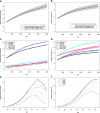Projection of the future diabetes burden in the United States through 2060
- PMID: 29903012
- PMCID: PMC6003101
- DOI: 10.1186/s12963-018-0166-4
Projection of the future diabetes burden in the United States through 2060
Abstract
Background: In the United States, diabetes has increased rapidly, exceeding prior predictions. Projections of the future diabetes burden need to reflect changes in incidence, mortality, and demographics. We applied the most recent data available to develop an updated projection through 2060.
Methods: A dynamic Markov model was used to project prevalence of diagnosed diabetes among US adults by age, sex, and race (white, black, other). Incidence and current prevalence were from the National Health Interview Survey (NHIS) 1985-2014. Relative mortality was from NHIS 2000-2011 follow-up data linked to the National Death Index. Future population estimates including birth, death, and migration were from the 2014 Census projection.
Results: The projected number and percent of adults with diagnosed diabetes would increase from 22.3 million (9.1%) in 2014 to 39.7 million (13.9%) in 2030, and to 60.6 million (17.9%) in 2060. The number of people with diabetes aged 65 years or older would increase from 9.2 million in 2014 to 21.0 million in 2030, and to 35.2 million in 2060. The percent prevalence would increase in all race-sex groups, with black women and men continuing to have the highest diabetes percent prevalence, and black women and women of other race having the largest relative increases.
Conclusions: By 2060, the number of US adults with diagnosed diabetes is projected to nearly triple, and the percent prevalence double. Our estimates are essential to predict health services needs and plan public health programs aimed to reduce the future burden of diabetes.
Conflict of interest statement
Ethics approval and consent to participate
Not applicable.
Competing interests
The author’s declare that they have no competing interests.
Publisher’s Note
Springer Nature remains neutral with regard to jurisdictional claims in published maps and institutional affiliations.
Figures
References
-
- Long-term Trends in Diabetes, [article online], Available from https://www.cdc.gov/diabetes/statistics/slides/long_term_trends.pdf.
MeSH terms
LinkOut - more resources
Full Text Sources
Other Literature Sources
Medical


